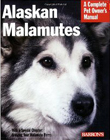
Alaskan Malamute: The Complete Pet Owner's Manual
Alaskan Malamutes are a big contrast to akitas in that they are usually very friendly with anyone who will pay them attention. They tend to stay puppyish for a long time, and are not as serious as an Akita. Like Akitas, however, Alaskan Malamutes are designed to work, like being in the company of their owners, and get bored unless they have something to do. Bored Malamutes can rearrange your home, and dig holes in your carpets and furniture.
Exercising a Malamute can be difficult, since they are not always easy to take on walks. Individuals vary, and while some can be trained fairly easily (for a spitz), others combine a number of challenges, such as poor recall, and being dog aggressive. Most Alaskan Malamutes will shoot off after small prey, like cats and squirrels. They are designed to be sled dogs, so if you are interested in this breed, it's worth finding out about sledding, and using them for the purpose they were designed for. Alaskan Malamutes are not as fast as Siberian huskies as sled dogs, but they are very strong, and have been used as freight dogs, where strength rather than speed is important. Well-behaved Malamutes can carry a dog backpack, and accompany you on long walks, though you may need to use a flexileash to ensure they stay with you, and may find controlling them difficult if they spot a small furry creature they want to chase. Pups need their exercise regulated for correct bone growth, as with all large-breed dogs. Like Sibes, Alaskan Malamutes tend to overeat when not working, and tend to wander if not confined securely. As they are good diggers, this means ensuring that the fence goes underground. It's also best not to leave them outside alone in the garden for long periods. Though they can stand the cold very well, they like to be with their human pack, and would really prefer the humans to be outside in the cold! Working sled dogs are usually kept in kennels, but dogs kept mainly as pets are likely to be bored if left outside and not worked much, especially if they are left alone, with no other dogs for company. Keeping sled dogs indoors does involve risk, since they can be destructive, and whether they are indoors or outside, they need to work. Generally, Alaskan Malamutes are more of a challenge than Siberian Huskies. They are bigger and more powerful, so more difficult to control if they are on a leash and want to take off after a cat. They also eat more.
Are Alaskan Malamutes good with children? This depends. They are a very powerful breed, and can easily knock over small children. Malamutes that don't have enough exercise can become boisterous and difficult, and are not good companions with children. They are also too powerful for most children to be able to handle on a lead. However, well-trained Malamutes that have enough exercise are usually very gentle and tolerant with children. They are also generally good with other dogs, but socialization is important, and even then there can be friction between dogs of the same sex. It is no fun walking a dog-aggressive Malamute because they are so strong, so it's well worth socializing them with other dogs when they are pups.
Alaskan Malamutes don't need much grooming, except when they 'blow' their coats, and they are clean dogs, usually housetrained very easily. They can be quite vocal, especially when bored, and they can make a surprising range of sounds. Common health problems include hip dysplasia and eye trouble. They need shade and water in summer, and should not be exercised when it's very hot.
Sikora's guide is an excellent introduction to the breed, though it is a little short. It's well worth reading if you are considering the breed, and want to know the pros and cons of Alaskan Malamutes, and get some idea of what living with one involves. There's a lot of help with training, and the book is very well illustrated. It's also an inexpensive book.



